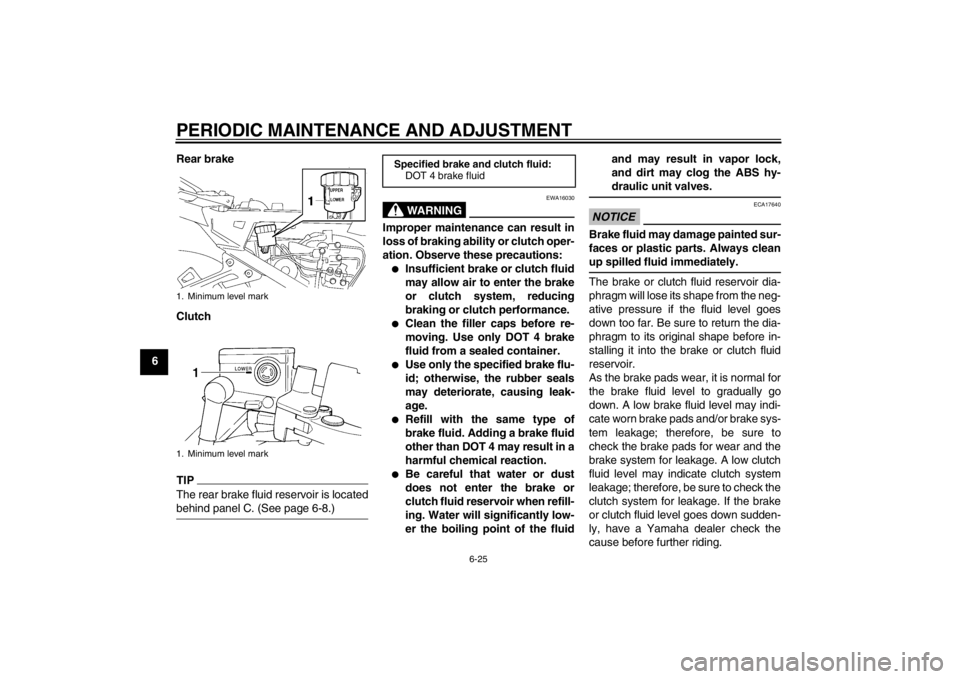2013 YAMAHA FJR1300A brake fluid
[x] Cancel search: brake fluidPage 92 of 118

PERIODIC MAINTENANCE AND ADJUSTMENT
6-25
6Rear brake
Clutch
TIPThe rear brake fluid reservoir is located
behind panel C. (See page 6-8.)
WARNING
EWA16030
Improper maintenance can result in
loss of braking ability or clutch oper-
ation. Observe these precautions:●
Insufficient brake or clutch fluid
may allow air to enter the brake
or clutch system, reducing
braking or clutch performance.
●
Clean the filler caps before re-
moving. Use only DOT 4 brake
fluid from a sealed container.
●
Use only the specified brake flu-
id; otherwise, the rubber seals
may deteriorate, causing leak-
age.
●
Refill with the same type of
brake fluid. Adding a brake fluid
other than DOT 4 may result in a
harmful chemical reaction.
●
Be careful that water or dust
does not enter the brake or
clutch fluid reservoir when refill-
ing. Water will significantly low-
er the boiling point of the fluid and may result in vapor lock,
and dirt may clog the ABS hy-
draulic unit valves.
NOTICE
ECA17640
Brake fluid may damage painted sur-
faces or plastic parts. Always clean
up spilled fluid immediately.The brake or clutch fluid reservoir dia-
phragm will lose its shape from the neg-
ative pressure if the fluid level goes
down too far. Be sure to return the dia-
phragm to its original shape before in-
stalling it into the brake or clutch fluid
reservoir.
As the brake pads wear, it is normal for
the brake fluid level to gradually go
down. A low brake fluid level may indi-
cate worn brake pads and/or brake sys-
tem leakage; therefore, be sure to
check the brake pads for wear and the
brake system for leakage. A low clutch
fluid level may indicate clutch system
leakage; therefore, be sure to check the
clutch system for leakage. If the brake
or clutch fluid level goes down sudden-
ly, have a Yamaha dealer check the
cause before further riding.
1. Minimum level mark
1. Minimum level mark
Specified brake and clutch fluid:
DOT 4 brake fluid
U1MCE0E0.book Page 25 Thursday, July 19, 2012 6:59 PM
Page 93 of 118

PERIODIC MAINTENANCE AND ADJUSTMENT
6-26
6
EAU22752
Changing the brake and
clutch fluids Have a Yamaha dealer change the
brake and clutch fluids at the intervals
specified in the periodic maintenance
and lubrication chart or in the TIP after
the periodic maintenance and lubrica-
tion chart. In addition, have the oil seals
of the brake and clutch master cylin-
ders and calipers as well as the brake
and clutch hoses replaced at the inter-
vals listed below or whenever they are
damaged or leaking.●
Oil seals: Replace every two
years.
●
Brake and clutch hoses: Replace
every four years.
EAU23095
Checking and lubricating the
cables The operation of all control cables and
the condition of the cables should be
checked before each ride, and the ca-
bles and cable ends should be lubricat-
ed if necessary. If a cable is damaged
or does not move smoothly, have a
Yamaha dealer check or replace it.
WARNING! Damage to the outer
housing of cables may result in in-
ternal rusting and cause interfer-
ence with cable movement. Replace
damaged cables as soon as possi-
ble to prevent unsafe conditions.[EWA10711]EAU23114
Checking and lubricating the
throttle grip and cable The operation of the throttle grip should
be checked before each ride. In addi-
tion, the cable should be lubricated by a
Yamaha dealer at the intervals speci-
fied in the periodic maintenance chart.
The throttle cable is equipped with a
rubber cover. Make sure that the cover
is securely installed. Even though the
cover is installed correctly, it does not
completely protect the cable from water
entry. Therefore, use care not to pour
water directly onto the cover or cable
when washing the vehicle. If the cable
or cover becomes dirty, wipe clean with
a moist cloth.
Recommended lubricant:
Yamaha Chain and Cable Lube or
engine oil
U1MCE0E0.book Page 26 Thursday, July 19, 2012 6:59 PM
Page 107 of 118

MOTORCYCLE CARE AND STORAGE
7-2
7
off any detergent residue using
plenty of water, as it is harmful
to plastic parts.
●
Do not use any harsh chemical
products on plastic parts. Be
sure to avoid using cloths or
sponges which have been in
contact with strong or abrasive
cleaning products, solvent or
thinner, fuel (gasoline), rust re-
movers or inhibitors, brake flu-
id, antifreeze or electrolyte.
●
Do not use high-pressure wash-
ers or steam-jet cleaners since
they cause water seepage and
deterioration in the following ar-
eas: seals (of wheel and swing-
arm bearings, fork and brakes),
electric components (couplers,
connectors, instruments,
switches and lights), breather
hoses and vents.
●
For motorcycles equipped with
a windshield: Do not use strong
cleaners or hard sponges as
they will cause dulling or
scratching. Some cleaning com-
pounds for plastic may leave
scratches on the windshield. Test the product on a small hid-
den part of the windshield to
make sure that it does not leave
any marks. If the windshield is
scratched, use a quality plastic
polishing compound after
washing.
After normal useRemove dirt with warm water, a mild
detergent, and a soft, clean sponge,
and then rinse thoroughly with clean
water. Use a toothbrush or bottlebrush
for hard-to-reach areas. Stubborn dirt
and insects will come off more easily if
the area is covered with a wet cloth for
a few minutes before cleaning.
After riding in the rain, near the sea oron salt-sprayed roadsSince sea salt or salt sprayed on roads
during winter are extremely corrosive in
combination with water, carry out the
following steps after each ride in the
rain, near the sea or on salt-sprayed
roads.
TIPSalt sprayed on roads in the winter may
remain well into spring.1. Clean the motorcycle with cold wa-
ter and a mild detergent, after the
engine has cooled down.
NOTICE: Do not use warm water
since it increases the corrosive
action of the salt.
[ECA10791]
2. After drying the motorcycle, apply a corrosion protection spray on all
metal, including chrome- and nick-
el-plated, surfaces to prevent cor-
rosion.
Windshield cleaningAvoid using any alkaline or strong acid
cleaner, gasoline, brake fluid, or any
other solvent. Clean the windshield with
a cloth or sponge dampened with a
neutral detergent, and after cleaning,
thoroughly wash it off with water. For
additional cleaning, use Yamaha Wind-
shield Cleaner or other quality cleaner.
Some cleaning compounds for plastics
may leave scratches on surfaces of the
U1MCE0E0.book Page 2 Thursday, July 19, 2012 6:59 PM
Page 112 of 118

SPECIFICATIONS
8-2
8
Secondary reduction ratio:2.698 (35/37 x 21/27 x 33/9)
Transmission type: Constant mesh 5-speed
Operation:
Left foot operation
Gear ratio: 1st:
2.529 (43/17)
2nd: 1.773 (39/22)
3rd: 1.348 (31/23)
4th:
1.077 (28/26)
5th: 0.929 (26/28)Chassis:Frame type:
Diamond
Caster angle: 26.00 °
Trail: 109 mm (4.3 in)Front tire:Type:Tubeless
Size: 120/70 ZR17M/C (58W)
Manufacturer/model:
BRIDGESTONE/BT023F F
Manufacturer/model: METZELER/Roadtec Z8
Rear tire:Type:Tubeless
Size:
180/55 ZR17M/C (73W)
Manufacturer/model: BRIDGESTONE/BT023R F
Manufacturer/model: METZELER/Roadtec Z8 CLoading:Maximum load:215 kg (474 lb)
(Total weight of rider, passenger, cargo and
accessories)Tire air pressure (measured on cold
tires):Loading condition:0–90 kg (0–198 lb)
Front:
250 kPa (2.50 kgf/cm², 36 psi)
Rear: 290 kPa (2.90 kgf/cm², 42 psi)
Loading condition: 90–215 kg (198–474 lb)
Front:
250 kPa (2.50 kgf/cm², 36 psi)
Rear: 290 kPa (2.90 kgf/cm², 42 psi)
High-speed riding: Front: 250 kPa (2.50 kgf/cm², 36 psi)
Rear: 290 kPa (2.90 kgf/cm², 42 psi)
Front wheel:Wheel type:Cast wheel
Rim size:
17M/C x MT3.50Rear wheel:Wheel type:Cast wheel
Rim size:
17M/C x MT5.50Unified brake system:Operation:Activated by rear brakeFront brake:Type:Dual disc brake
Operation: Right hand operation
Specified brake fluid:
DOT 4Rear brake:Type:Single disc brake
Operation:
Right foot operation
Specified brake fluid: DOT 4Front suspension:Type:
Telescopic fork
Spring/shock absorber type: Coil spring/oil damper
Wheel travel: 135.0 mm (5.31 in)
U1MCE0E0.book Page 2 Thursday, July 19, 2012 6:59 PM
Page 115 of 118

INDEX
AABS ...................................................... 3-26
ABS warning light ................................... 3-5
Accessory box ...................................... 3-36
Air filter element, cleaning .................... 6-17
Auxiliary DC jack .................................. 3-45
Auxiliary light ........................................ 6-36BBattery .................................................. 6-31
Brake and clutch fluid levels, checking ............................................. 6-24
Brake and clutch fluids, changing ......... 6-26
Brake and clutch levers, checking and lubricating ........................................... 6-27
Brake and shift pedals, checking and
lubricating ........................................... 6-27
Brake lever ........................................... 3-26
Brake lever free play, checking ............ 6-23
Brake light switches .............................. 6-23
Brake pedal .......................................... 3-26CCables, checking and lubricating .......... 6-26
Care ........................................................ 7-1
Catalytic converters .............................. 3-31
Centerstand and sidestand, checking and lubricating .................................... 6-28
Clutch lever.................................. 3-25, 6-22
Coolant ................................................. 6-16
Cowling vents, opening and closing ..... 3-37
Cruise control indicator lights ................. 3-4
Cruise control switches ......................... 3-24
Cruise control system ............................. 3-6DDimmer/Pass switch ............................. 3-23 D-mode (drive mode) ............................ 3-22
EEngine break-in .......................................5-3
Engine idling speed, checking............... 6-18
Engine oil and oil filter cartridge ............ 6-12
Engine trouble warning light .................... 3-4FFinal gear oil.......................................... 6-14
Front and rear brake pads, checking .... 6-24
Front fork, adjusting .............................. 3-39
Front fork, checking...............................6-29
Front turn signal light............................. 6-34
Fuel ....................................................... 3-30
Fuel consumption, tips for reducing ........ 5-3
Fuel tank breather/overflow hose .......... 3-31
Fuel tank cap......................................... 3-29
Fuses, replacing .................................... 6-32HHandlebar position, adjusting ................ 3-37
Handlebar switches ............................... 3-23
Hazard switch........................................ 3-24
Headlight beams, adjusting ................... 3-37
Headlight bulb ....................................... 6-34
High beam indicator light......................... 3-4
Horn switch ........................................... 3-24IIdentification numbers ............................. 9-1
Ignition circuit cut-off system ................. 3-43
Immobilizer system .................................3-1
Immobilizer system indicator light ........... 3-6
Indicator lights and warning lights ........... 3-4LLicense plate light bulb, replacing ......... 6-35
MMain switch/steering lock ........................ 3-2
Maintenance and lubrication, periodic .... 6-4
Maintenance, emission control system ... 6-3
Matte color, caution ................................ 7-1
Menu switch .......................................... 3-24
Model label ............................................. 9-1
Multi-function meter unit ......................... 3-9NNeutral indicator light .............................. 3-4OOil level warning light .............................. 3-4PPanels, removing and installing .............. 6-8
Parking.................................................... 5-4
Part locations .......................................... 2-1RRear suspension, lubricating ................ 6-29
Rear view mirrors.................................. 3-39
Rider seat height, adjusting .................. 3-33SSafety information ................................... 1-1
Seats..................................................... 3-32
Select switch ......................................... 3-24
Shifting .................................................... 5-2
Shift pedal ............................................. 3-25
Shock absorber assembly, adjusting .... 3-41
Sidestand .............................................. 3-42
Spark plugs, checking........................... 6-11
Specifications.......................................... 8-1
Start/Engine stop switch ....................... 3-24
Starting the engine.................................. 5-1
Steering, checking ................................ 6-30
Storage ................................................... 7-4
U1MCE0E0.book Page 1 Thursday, July 19, 2012 6:59 PM